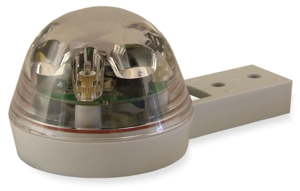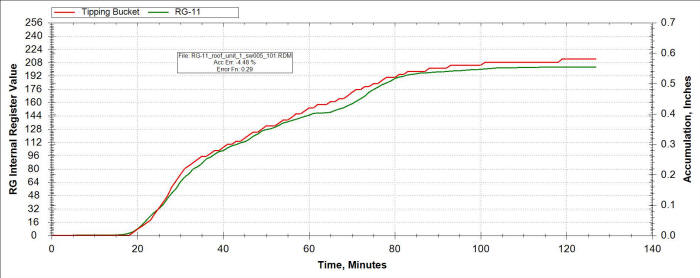Not as accurate as a properly maintained Tipping Bucket, but a better choice for many applications.

We do not guarantee or specify an accuracy for the RG-11, but these are the results we have seen for our three testing stations:
Cumulative Error for the three stations: -10% to -28%
Standard Deviation of error for each rain event: 36%
The standard deviation means that roughly 2/3 of the time the RG-11 will be within 36% of the tipping bucket. Much of the time the RG will read close to the tipping bucket, but outlier events can be significantly off.
Data taken between October 2011 and November 2012. Software revision – 12 (current is 16, but does not change accuracy). Units for testing range between new and three years of weathering and wear, including tests with intentionally scuffed / excessively worn units.
Snow melt is not included in the totals. Percent error for rain events is for events over 0.02" accumulation. (Tipping bucket does not register below about 0.02")
There is not a clear correlation of any readily measurable parameter. The biggest factor is surface condition.
A few notes:
- The RG-11 is great for qualitative measurements versus quantitative, i.e. you’ll know when there’s a heavy rain rather than a light mist but not an exact amount of rain.
- A tipping bucket will typically miss the first couple of hundreds of an inch of rain as the collecting funnel fills. The RG-11 starts totalizing right away, and is thus more accurate than a tipping bucket for small rainfall accumulations..
- If the tipping bucket mechanism gets stuck for any reason, the tipping bucket will not read at all. If the tipping bucket becomes clogged it may not read. The RG-11 is more accurate in these conditions.
- The RG-11 will generally not detect snow. A tipping bucket will read the snow after it melts.
- We know of no above-freezing condition that will cause the RG-11 to fail to detect rain.
- We know of no dry condition that will cause the RG-11 to falsely indicate rain.
The RG-11 is a great choice for:
- Applications where maintenance is difficult
- Marine or mobile rain sensing, where motion would make a tipping bucket not work.
- Sensing very small amounts of rain for data gathering and correlating to other factors
- Use in conjunction with tipping buckets to extend the range to small amounts, or for increased system reliability.
- Qualitative data gathering for applications such as erosion monitoring.
- Input for an irrigation system.
- input for process control.

The above graph show the rainfall accumulation of an RG-11 (green line) and a reference tipping bucket (red line), during a rainstorm at our headquarters in Minnesota on October 22, 2010.
